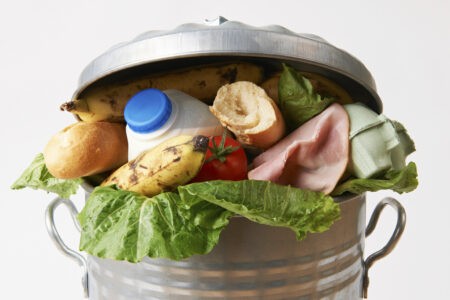By: Jordan Green, University of Saskatchewan Student
Have you ever wasted food? The answer is that most of us have at some point in our lives whether it’s scraps left over from a meal or entire food products. But just how bad is Canada’s food waste problem? The scary truth is that it’s one of the worst in the world. The Commission for Environmental Cooperation found that 396 kilograms of food per capita are wasted every year in Canada. When measuring this in terms of production the amount of food wasted was $31 billion.
Why is Food Waste Such a Problem?
Food waste is one of the largest issues in agriculture and food policy, yet it is one that commonly remains out of the spotlight. One of the main reasons there is a large amount of food wasted is because in North America we spend only 6.4% of our household income on food. This percentage is small on a global scale as developing countries spend anywhere from 43%-56% of their budget on food. A large number of consumers also don’t know enough about food safety. Most people would rather throw away food then take the ‘risk’ of eating it past the expiration date. However, food poisoning is almost always caused by improper handling of food or contamination of the food supply line rather than spoilage. People don’t realize that these expiration dates are mere guidelines as there is no specific way to determine when food will actually spoil. Proper cooking, handling and the storage all affect how safe certain meats are to consumers rather than if it’s past the expiration date or not. One of the most common things that get discarded is milk. However, milk can be drunk in Canada for periods after the expiration date because the pasteurization process that it must undergo kills any possible contaminants. To determine if milk is spoiled it’s as simple as doing the “smell test” to determine if there is a sour odour. This is why it’s crucial for consumers to use their senses to determine if something has actually spoiled rather than the date on the food item. Food waste also occurs in grocery stores as two to three percent of the stock is commonly thrown out due to these expiration dates.
The Importance of Reducing Food Waste
The worldwide population is expected to reach 9.6 billion by 2050. The best way to feed this large of a population with limited resources is to reduce the amount of food we as consumers waste. Growth in the population also means a growth in the middle class with more and more consumers demanding meat products. These meat products are not easily made and perish faster than other foods. In addition, they are currently 795 million people malnourished worldwide. This number will only continue to grow as the demand for food increases as well as the amount of food wasted.
The Effect of Wasting Food
You may not think twice when throwing out food but this waste has a much bigger effect then most people realize. The food that is thrown away accumulates in landfills and releases a greenhouse gas called methane which hurts the environment. The amount of food that is wasted is comparable to the yearly use of 30 million acres of land, 4.2 trillion gallons of water, as well as 780 million pounds of pesticide.
Tips to Reduce Food Waste
- Keep grocery receipts and highlight items when they are thrown away. This is a beneficial way of seeing how much food your household wastes and how much money that thrown away food costs you.
- Composting and donating to local food banks as composting can prevent almost 30% of your food waste from ending up in the garbage.
- Plan out meals in advance to reduce over buying when you go to the grocery store.
- Store foods in appropriate places to avoid them getting lost at the back of the fridge or forgotten about.
[su_accordion][su_spoiler title=”References” open=”no” size=”28″ style=”fancy” icon=”plus” icon_color=”3D6F77″ anchor=”” class=””][su_list icon=”icon: shopping-cart” icon_color=”#47907C”]
- Bellemare, M., Çakir, M., Peterson, H., Novak, L., & Rudi, J. (2017). On the Measurement of Food Waste. American Journal of Agricultural Economics, 99(5), 1148-1158.
- Cowan, S. (n.d.). Composting. Retrieved from https://learn.eartheasy.com/guides/composting/#howtocompost
- How bad is Canada’s food waste problem? Among the world’s worst, report finds | CBC Radio. (2018, April 09). Retrieved from https://www.cbc.ca/radio/thecurrent/the-current-for-april-52018-1.4605392/how-bad-is-canada-s-food-waste-problem-among-the-world-s-worst-reportfinds-1.4606012
- Klosowski, T. (2016, January 28). Expiration Dates on Your Food Mean Nothing. Retrieved from https://lifehacker.com/why-expiration-dates-on-your-food-mean-nothing-1755569296
- McClellan, J. (2017, May 31). Americans waste food because we’re confused – and because we can. Retrieved from https://www.usatoday.com/story/news/nation-now/2017/05/30/whyamericans-waste-so-much-food/355864001/
- Milman, O. (2018, April 18). Americans waste 150,000 tons of food each day – equal to a pound per person. Retrieved from https://www.theguardian.com/environment/2018/apr/18/americans-waste-food-fruit
- Petronzio, M. (2015, February 15). 11 practical ways you can reduce food waste and save money. Retrieved from https://mashable.com/2015/02/15/food-waste-tips/#df2LRMFQSgqd
- Poyatos-Racionero, Ros-Lis, Vivancos, & Martínez-Máñez. (2018). Recent advances on intelligent packaging as tools to reduce food waste. Journal of Cleaner Production, 172, 3398-3409.
- Sun, Lu, Gao, Jiang, Du, Shen, . . . Wang. (2018). Impacts of food wastage on water resources and environment in China. Journal of Cleaner Production,185, 732-739.
- Wilhelm, M. (2018, April 16). Grocery Stores Get Mostly Mediocre Scores On Their Food Waste Efforts. Retrieved from https://www.npr.org/sections/thesalt/2018/04/16/602813694/grocery-stores-get-mostlymediocre-scores-on-their-food-waste-efforts
- World Hunger Statistics. (n.d.). Retrieved from http://www.foodaidfoundation.org/world-hungerstatistics.html
[/su_list] [/su_spoiler][/su_accordion]

Jordan Green
My name is Jordan Green and I am in my second year of Agribusiness with a minor in Field Crop Production at the University of Saskatchewan. Upon graduation, I plan to work in the industry to help feed the growing population as well as correct the misconceptions surrounding agriculture. I was born and raised on a family grain farm outside of Rosetown, Saskatchewan. In my spare time, I enjoy going to the lake, surfing, and spending time with family and friends.



It would be interesting to know the amount of food that is wasted by category, i.e. by the consumer, at the store, and at the producer level. for example crooked carrots never leave the farm or packing house due to govt. regulations.
We also have to recognize that there are attempts being made to reduce waste. There are hotels that donate prepared food that has never left the kitchen, there are bakeries that donate day old bread, also there is an organization that takes off grade produce, dehydrates it and makes soup mix that is donated in shipping container size quantities to places in the world suffering from natural catastrophes (Prairie Gleaners). There is also a company that collects wasted produce from stores, composts it, mixes the compost with sulphur and sells the fertilize to farmers. By recognizing these and other efforts, I believe, encourages others to do the same or something similar.
According to VCM International and the National Zero Waste Council, in 2014 of the $27 billion wasted in Canada the supply chain accounted for: consumers (47%), processing (20%), retail stores (10%), farms (10%), restuarants & hotels (9%), transport distribution (4%) and interntional cartering waste (a.k.a air transit = 1%). http://www.nzwc.ca/focus/food/Pages/default.aspx In 2015 Maclean’s reported that of the $31 billion in Canadian food waste, consumers at home made up 47% of that waste = $1,500 / household. https://www.macleans.ca/society/life/how-to-solve-the-food-waste-problem/
It looks like the most waste falls on the consumer. Which makes sense, as for many of us who are wasting food, food security is not an issue for us. In addition, consumers are the end of the food chain, which means we buy it but we don’t sell it. Other segments of the supply chain for a profit reason (could be concerns of sustainabiliy as well) want to find a use for the scraps or wastes of food, rather than taking a hit of unused product. The crooked carrot might not end up in your grovery store, but it likely goes onto animal feed, or further processing. It might not get a premium price, but some industry wants those cheaper crooked carrots, and the producer would rather sell it than lose money on it.
There are lots of attempts being made out there to requde food waste, your right on that Dennis, and we should be celebrating those efforts!